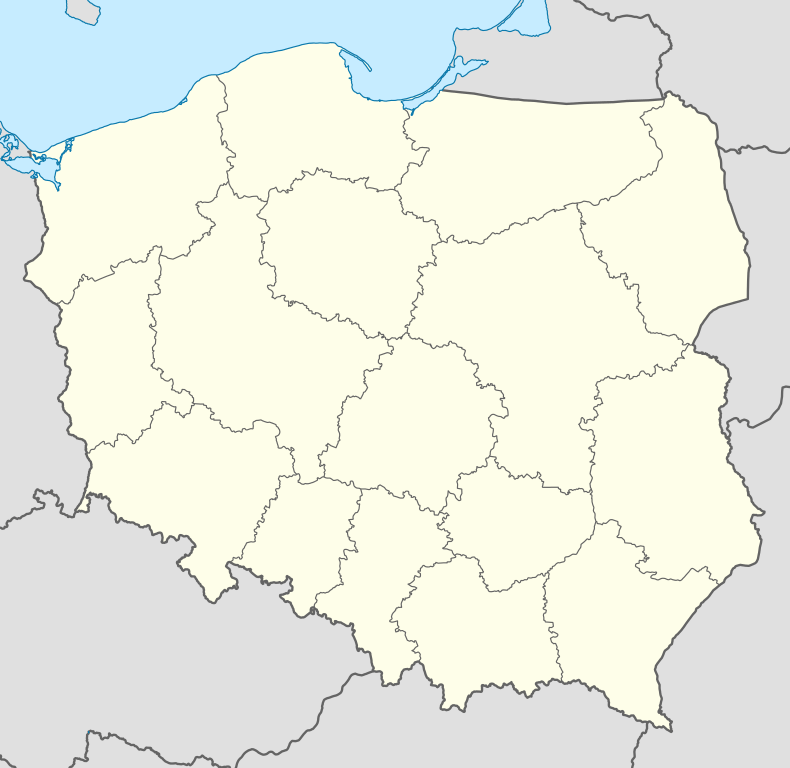Brzozów
| Brzozów | ||
|---|---|---|
|
| ||
| ||
 Brzozów | ||
| Coordinates: 49°42′N 22°01′E / 49.700°N 22.017°E | ||
| Country |
| |
| Voivodeship | Subcarpathian | |
| County | Brzozów County | |
| Gmina | Gmina Brzozów | |
| Government | ||
| • Mayor | Józef Rzepka | |
| Area | ||
| • Total | 11.45 km2 (4.42 sq mi) | |
| Population (2006) | ||
| • Total | 7,705 | |
| • Density | 670/km2 (1,700/sq mi) | |
| Time zone | CET (UTC+1) | |
| • Summer (DST) | CEST (UTC+2) | |
| Postal code | 36-200 | |
| Car plates | RBR, KSD, KUD, KUB | |
| Website | http://www.brzozow.pl | |
Brzozów [ˈbʐɔzuf] (Ukrainian: Березів, Bereziv; Yiddish: ברעזשוב-Brezhiv; lat. Brozovia, or Prozzow) is a town in south-eastern Poland, with 7,677 inhabitants (02.06.2009).[1] It is situated in Subcarpathian Voivodeship (since 1999) and is the seat of both Brzozów County and the smaller administrative district of Gmina Brzozów. It lies 38 kilometres (24 mi) south of the city of Rzeszów.
History
Brzozów was founded in 1359, Brzozów took on the name of an earlier, adjacent settlement of the 14th century, which gradually over time came to be known as Stara Wieś (Old Village). A large Jesuit Basilica and Monastery, built in 1760, is found in Stara Wieś. Queen Mary donated Brzozów and four other villages to the Bishops of Przemyśl in 1384. From the middle 14th to the early 19th centuries, the Bishops of Przemyśl resided principally at Brzozów.
Tatar attacks took place in 1525, 1623–25, 1629 and with heavy losses in 1674. Afterwards, Brzozów declined commercially until the 19th century.
From the first partition of Poland in 1772 until 1918, the town was part of the Austrian monarchy (Austria side after the compromise of 1867), head of the district with the same name, one of the 78 Bezirkshauptmannschaften in Austrian Galicia province (Crownland).[2]
Before WW2 there was a Jewish community of about 1300 in Brzozów. All were sent to death camps or murdered by the Nazis during the war. Since then, there has been no Jewish presence in the town.[3]
Economy
In 1550-1650, nineteen trades were practiced here including cloth-making, food processing, and leather-making as well as wood, metal, and ceramic trades. The first hospital of record is mentioned in 1518. A parish school was in existence in the early 16th century, and annual elections of mayors and judges, subject to approval of the bishop, commenced in 1410. The town for hundreds of years had been known for the manufacture of combs, but the industry disappeared by the 1960s. Manufacture of oils was another industry in Brzozów; walnut oil was a famous product reportedly supplied to the royal table in Kraków in the 16th century. Oils were also produced from plum core.
A post-office was opened in 1851[4]
Families
- Ciesla Family
- Kroliki family
Gallery
-
Town hall
-
Seminarium
-

Church
International relations
Twin towns — Sister cities
Brzozów is twinned with:
See also
- Lendians
- Great Moravia
- Galicia (Central Europe)
- Pogórzanie
- Walddeutsche
References
- Notes
- ↑ "Population. Size and structure by territorial division". © 1995-2009 Central Statistical Office 00-925 Warsaw, Al. Niepodległości 208. 2009-06-02. Retrieved 2009-06-22.
- ↑ Die postalischen Abstempelungen auf den österreichischen Postwertzeichen-Ausgaben 1867, 1883 und 1890, Wilhelm KLEIN, 1967
- ↑ "Sol Filler". Holocaustcentre.org.nz. Retrieved 2013-03-12.
- ↑ Handbook of Austria and Lombardy-Venetia Cancellations on the Postage Stamp Issues 1850-1864, by Edwin MUELLER, 1961.
External links
| Wikimedia Commons has media related to Brzozów. |
Coordinates: 49°42′N 22°01′E / 49.700°N 22.017°E
| |||||||||||||||||
| ||||||||||||


